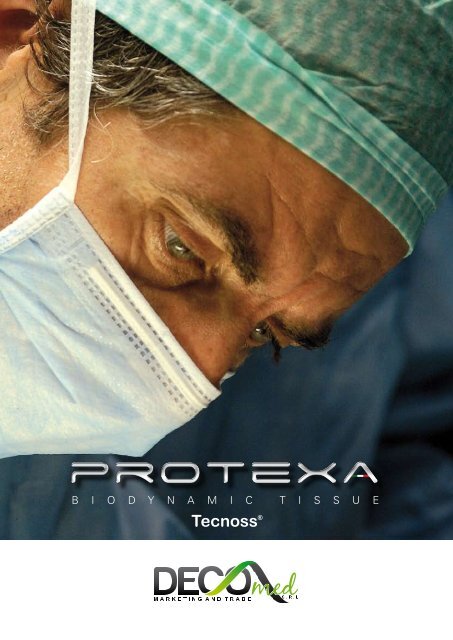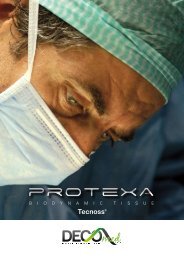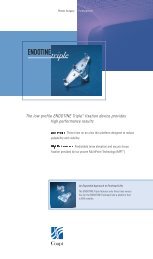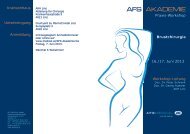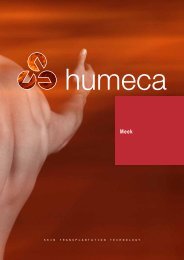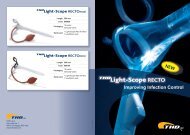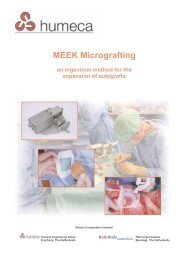product information - AFS Medical
product information - AFS Medical
product information - AFS Medical
- No tags were found...
You also want an ePaper? Increase the reach of your titles
YUMPU automatically turns print PDFs into web optimized ePapers that Google loves.
i o d y n a m i c t i s s u eTecnoss, an Italian companywith a site in Turinis a leader in the tissuebioengineering sector.Thanks to its patents (ECPT)it has been deantigenizingheterologous matrixes for 15 years,and distributing its biomaterials in40 countries around the world.350,000 implants to date.DECOmed, an Italian companywith a site in Venicehas been present in themedical-surgical marketsince 1989.Distributing specialistand high technology <strong>product</strong>sthroughout Europe.Tecnoss and DECOmed present Protexa,an Italian project set up in 2008and developed in collaboration with surgical specialists:supplying safe, high technology <strong>product</strong>sat an accessible price.Protexa. Made in Italy.www.protexa.itinfo@decomed.it
i o d y n a m i c t i s s u eYour Mastery...The ‘direct’ repair of the ventral hernia is hindered by the high percentage of recurrencesdue to the tension exercised on the fascia of the suture and to the conditions of the tissuetropism.Since the first half of the 900’s the most diverse and inert materialshave been researched for use in the closure of a wound or incision withoutplacing tension on the fascia. Only in the second half of the 900’swas polypropylene used, having been shown to be the most fit for thispurpose. There are also meshes in polypropylene adapted for cominginto contact with the bowel loops, and in polyester coated with absorbablesubstances which facilitate the rehypertonization, some coated inIs it possiblea more enlargedindication?silicone, others in PTFE.The problem with this type of prosthesis is the fact that, although inert,it is a foreign body and these can bring complications such as infection,fistulization and erosion of the skin.There are some predisposing conditions to infection which put the successfuloutcome of the implantation at risk.In order to prevent this, it is imperative to be able to trust in a materialwhich gives us the same guarantee as asynthetic prosthesis (resistance to tension, malleability,biocompatibility, allergy resistance),but doesn’t behave as foreign body. Biologicalprostheses is a category which incorporates allof these characteristics, but at the same timeguarantees better protection against infection.The site of the positioning of the organic prosthesisis similar to that of a synthetic mesh,which is fixed around the circumference of awound or incision with re-absorbable stitchesso as to keep it in position. The biologicalprosthesis offers the guarantee that once implanted,it becomes a structure recognized bythe organism. It becomes revascularized andreinforces the deficit in the fibrotic structure.The application of this material is thereforeused electively in all cases where there is potentialcontamination of the wound (the presenceof a colostomy, tearing of the intestine, ahistory of infection of the site)Should the producers of the <strong>product</strong> renderit more accessible in terms of cost, it wouldbe available for more widespread use also inpatients at risk from potential infection due tocomorbidity (immunodeficiency, advanced age,nutritional state, diabetes, obesity, corticosteroidtherapy etc.)
i o d y n a m i c t i s s u e...our backgroundFor 15 years the Tecnoss laboratory of Turinhas been deantigenizing under its ownheterologous matrix patent.In forty countries all over the world, surgical specialists use Tecnoss biomaterials. To date, more than three hundred and fifty thousand implants.This expansion in the market has effectively absorbed the cost of the research, and today, has allowed the extension of the use of a biologicalprosthesis which meets economical needs along with the need for more advanced surgical performance.FAQQ: Can the biological prosthesis be reabsorbed,allowing the hernia to reform?A: No. The prosthesis constitutes a supportwhich re-enforces the abdominal wall,being recognized, revascularized and becominga substitute for the missing tissue.Q: Can the prosthesis be rejected?A: No. The prosthetic material is properlytreated (deanitgenized). It is a natural constituentof the organism, and in this way isperfectly biocompatible.Q: Can the prosthesis be encapsulated as aforeign body?A: No. Being completely biocompatible, it becomesrevascularized and entirely accepted.For this reason even its macroscopicrecognition can be difficult in the case ofrevision.Q: Can the prosthesis be used for when performingMiles’operation?A: Yes. Since it acts as a filler, it can be usedboth for closure after the pelvic explorationin laparoscopy, and open surgeries. It canalso be used to reinforce the posterior bandof the ano praeter.Q: Are there clinical indications for using thebiological prosthesis during the Nissenfundoplication for hiatus hernia?A: Yes. The organic prosthesis is perfectlyadapted for reinforcing the proximity ofthe diaphragmatic pillars, also in the caseof revision, or to bridge the gap should thepillars be too far apart.Q: Can the prosthesis be used for, and how dothey function in pelvic floor reconstructionsurgery?A: They can assuredly be used and give moresecurity in cases at risk of infection due tothe accidental opening of the colon and/orvagina.Q: Can the biological prosthesis be used incases in which there is the presence ofmacerated skin, problems of regenerationof the tissues, proximity of the stomy?A: Yes. The biological prosthesis provide thebest guarantee against risk of infection,and it is therefore possible to use it alsoin the presence of colostomy (parastomalhernia) in patients with ascites, maceratedskin and dystrophic tissue.Q: Is it possible to use the prosthesis for immunodepressedpatients?A: Yes. Ventral hernias in transplant patientsare relatively common, and the dilemma ofchoosing whether or not to use prostheticmaterials which may be the cause of infection,is resolved by using a biological prosthesis.Q: How does the biological prosthesis performwhen used with Trocar?A: It performs excellently. It is easy to roll andinsert into the trocar, and likewise as easyto extract and extend.
i o d y n a m i c t i s s u eGuided tissue regenerationThe structural integrityof the extracellular matrix:A key factor in its clinical successThese characteristics of the Tecnoss manufacturing process morethan adhere to the safety requirements; a substantial cellular andvascular colonization of Protexa, for close contactand a gradual remodeling of the endogenous neo-tissue. In fact, it isthe collagen preserved in the integrated extracellular matrix whichhas a fundamental role in the tissue regeneration, as:a) It acts as a sound substrate for platelet activation and aggregation;b) It is able to attract and stimulate the differentiation of mesenchymalstem cells in the bone marrow;c) It increases the levels of proliferation of fibreblasts by 2/3 times ;d) Contact with it promotes the aggregation and subsequent plateletlysis, which is the very first stage of tissue healing.1) Salasznyk RM, et al. Journal of Biomedicine and Biotechnology (2004),1:24-342) Hsu FY, et al. Biomaterials (1999), 20: 1931-1936– The platelets are the key players duringthe first phase of the healing process,when, following a lesion, initially a fibrindeposit and the formation of blood clotstake place; This stage is characterized bysignificant activation of the chemical signsmediated by cytokines and growth factors.In fact, the primary post haemorrhagic clotformation process through platelet aggregationand lysis, determines the release ofboth the coagulation cascade factors andof the growth factors including PDGF,I’IGF1, I’IGF2, AND VEGF, which are knownfor their activating effects on fibroblasts.The identification of thesequence of events whichbring about guided tissueregeneration has allowed usto indentify the key factorsin the process of guiding; thesimultaneous presence of threefundamental components is theprerequisite for the ‘de novo’formation of tissue.– The fibroblastic precursors are derivedfrom mesenchymal bone marrow stemcells, once they are differentiated fibroblaststhrough collagen synthesis and othercomponents of the extracellular matrix,they become responsible for the secondphase of the guidance process.– An insoluble substrate, which acts as asuitable foundation to the process of tissueregeneration, and carries out the supportfunctions and guidance of the formationof new tissue. For example an integratedextracellular matrix.The continued progress in the comprehensionof biological mechanisms whichregulate morphogenesis of the tissue canalso be capitalized on. They can aid thedevelopment and expansion of both naturaland artificial <strong>product</strong>s able to restore ormaintain the function of damaged tissues1, 2, 3and organs (tissue engineering)1) Griffith LG, Naughton G. Science (2002); 295:1009-142) Reddi AH. Tissue Eng (2000); 6: 351-593) Nakashima N, Reddi AH. Nature Biotechnology(2003); 9: 1025-32
i o d y n a m i c t i s s u eThe ProductCharacteristics: a Collagen membrane obtained from porcine dermis, using the exclusiveprocess of Enzymatic-Chemical-Physical Treatment at Low Temperature (ECPT LT ). Its consistencyand resistance allow perfect stabilization, as well as prolonged protection of thereceiving site after draining and suturing the surgical flaps.Clinical Indication. A matrix of biological tissue to repair, support andregenerate sections of lost tissue, either as membrane protection, or aspartial or full reconstruction and recovery of the sections of tissue lost.Packaging. Double packaged in sterile, single use form.Sterilization. Product sterilized by gamma ray.Warning. The <strong>product</strong> has not been tested on pregnant patients.Instructions for use. Open the packaging and immerse the membranein a tepid, sterile saline solution for 15-20 minutes. Afteradapting the membrane to the required shape and size using sterileinstruments, position it onto the receiving site, and proceedwith the suture of the surrounding tissue.Should the <strong>product</strong> be exposed, its removal is recommended onlyin the presence of an evident superinfection, as the size and natureof the <strong>product</strong> allow healing of the wound by secondary intention.Safely from nature to manTecnoss develops and manufactures animal-derived biomaterials from which they originatenew concept medical devices intended to provide valuable and innovative aids which assistthe surgeon and give clinical benefits to the patient.A special technology is used in the preparation of the materials. Thistechnologyenables the neutralization of antigenic <strong>product</strong>s presentin animal tissue (achieving biocompatibility), allowing you to obtainunique <strong>product</strong>s which meet every surgical need.Thanks to Tecnoss’ biomaterials it is possible to obtain excellent resultsin healing, characterized by active colonization of the recipient site bythe cells of the patient in order to facilitate the process of fully recoveredinjured tissue.The raw materials which Tecnoss uses in its <strong>product</strong>s derive from Italianraised animals, selected and certified under the control of the ServizioSanitario Nazionale Veterinario (The national veterinary sanitationservice). Tecnoss biomaterials conform to the <strong>product</strong>ion regulationsof the European Directive 93/42/CEE (D.Lgs 47/97 and Modified Directive2007/47/CEE), 2003/32/CE (D.Lgs 67/2005). The Istituto Superioredi Sanità (The Higher Institute of Health) is the notified body(0373) for the CE mark of Tecnoss’ medical devices. The organic matrixfrom which Tecnoss’ line of medical devices is derived is subject to ISO10993, which is a series of biological and histocompatibility tests fromwhich the complete and perfect bioavailability and biocompatibility ofthe <strong>product</strong>s have emerged.
i o d y n a m i c t i s s u eHistologicalExaminationProtexaProtexaSamples of deantigenizedporcine collagenprosthesis using theTecnoss method.The histological preparations were set upusing an uncontaminated sample of TecnossDermis (Protexa) hydrated according to theinstructions for use on patients, subjected tobrief fixation (1 hour) in formalin, processedaccording to standard procedures and stainedin hematoxylin-eosin.AUTOLOGOUS TISSUEAUTOLOGOUS TISSUEA sample of tissue taken sixmonths after implantation,during unrelated surgery.The fibrous-connective tissue of the patientand porcine collagen membrane obtained bythe Tecnoss method can be recognized. Thereis a complete absence of inflammatory reactionon the interface between the prosthesisand autologous tissue.The histological examination demonstratesthat the prosthesis consists solely of collagenfibres without cellular elements.Immunohistochemical investigations demonstrateda negative result both for vimentin andCD31.The colonization of the prosthetic membraneby newly formed tissue can be seen, exhibitedby the presence of newly formed vesselsor fibroblastic cells, highlighted by vimentin,between the collagen fibres of the membraneprotex. The lack of inflammatory reaction, demonstratedby the presence of few lymphocytescan be appreciated.Vimentin: is one of the five cytoplasmic intermediatefilaments (MW 57,000).and present in mesenchymal cells such as fibroblasts,endothelial cells and smooth muscle cells.By kind permission of Prof. A. Iannucci Verona, ItalyProtexaProtexaBy kind permission of Prof. A. Iannucci Verona, Italy
i o d y n a m i c t i s s u eClinical IndicationsCertification and referenceswhich was accentuated during straining. Itwas decided to repair the area of weaknessusing biological prosthetic material (Protexa)as closing first was not feasible and the useof another type of synthetic graft was considered,given the anatomical location, to beputting the patient at high risk of infection.prosthesis (Protexa) was also used to bridgethe fascial defect.By kind permissionof Doctor U. Tedeschi. Verona, ItalyProtexaPatient underwent protective colostomyperformed during an operation for intestinalresection and reconstruction performedin emergency for perforated diverticulum.Some months later the patient developed asignificant ventral hernia. The surgical programwas to restore the intestinal continuity,close the ostomy, and to concurrently conducta massive incisional hernia repair. Given thepossibility of infection with a synthetic graft,the use of a biological prosthesis (Protexa)was decided upon.By kind permissionof Doctor U. Tedeschi. Verona, ItalyProtexaPatient underwent amputation of the coccyxdue to painful subluxation following a fall. Inthe area of the coccyx a symptomatic herniacan be seen with herniation of the rectum,By kind permissionof Doctor U. Tedeschi. Verona, ItalyProtexaPatient operated on for anterior resectiondue to rectal cancer in December 2006. Duringsurgery was subjected to IntraOperativeRadiation Therapy (IORT). The foreseenpost-operative radiotherapy was carriedout. The patient suffered an anastomoticleakage with entero-cutaneous fistula. Forthis reason a colostomy was given. Anastomoticdehiscence slowed the healing process,delaying recanalization. Meanwhile aparastomal hernia and a middle incisionalhernia developed. The surgical program wasto restore the intestinal continuity, closingthe stoma, and to concurrently repair themassive hernia. Given the possible infectionof any synthetic graft, the use of the biologicalprosthesis was decided upon. It wasdecided to first repair the hernia, excludingthe site of the stoma and subsequently recanalizethe patient. A piece of biologicalProtexaMale patient suffering from Crohn’s diseasehad previously been given a sigma resectionin 1997, accessed via right pararectal,and right hemicolectomy and ileal resectionin 2004, via Xiphopubic midline incision.The patient came under observation for aterminal stenosis due to ileal segment anda fistula enterocutanea. During interveningperiods had undergone surgery and medicaltherapies (anticancer drugs, steroids, immunosuppressantsand monoclonal antibodies).It should be noted that following the twosurgical operations the patient had a xiphoumbilicalhernia with atrophy of the rightrectus abdominis by denervation. The patientunderwent surgery due to vascular insufficiencyconsisting of resection of the stenotictract and ileal tract and of the remainingtransverse colon via middle xipho- pubic approach.For abdominal restraint a biologicalprosthesis (Protex) was opted for due to thehigh risk of infection.By kind permissionof Doctor R. Merenda. Mestre (VE), ItalyProduct code 1,4 mm Sizes Product code 0,9 mm Product Description QuantitiesED05PS 5 cm x 5 cm ED05FS porcine dermis 1 piece per packageED10PS 10 cm x 10 cm ED10FS porcine dermis 1 piece per packageED07PS 14 cm x 8 cm ED07FS porcine dermis 1 piece per packageED20PS 20 cm x 10 cm ED20FS porcine dermis 1 piece per packageED24PS 25 cm x 18 cm ED24FS porcine dermis 1 piece per packageED32PS 30 cm x 20 cm ED32FS porcine dermis 1 piece per packagewww.protexa.it
2 3 4 5 6 7 8 9 10 11 12 13 14 15 16 17 18 19 2029 28 27 26 25 24 23 22 21 20 19 18 17 16 15 14 13 12 11 10 9 8 7 6 5 4 3 2ED05PSED10PSED07PSED20PSED24PSVia delle Industrie 2/4 - 30020 Marcon (VE) Italytel. +39 041 5020370 - fax +39 041 5020366info@decomed.it - www.protexa.itdistributorgrafiklo@libero.it


